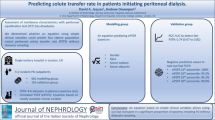Abstract
The peritoneal equilibration test (PET) is the gold standard method for defining peritoneal membrane permeability and for prescribing peritoneal dialysis (PD) therapy on an individual basis. However, it is laborious, consumes nursing time, and requires many hours to be performed. Therefore, several authors have attempted to validate a short PET protocol, with controversial results. To evaluate the concordance between the 2-h (short) and 4-h (classical) peritoneal equilibrium test, a prospective observational protocol was applied in three PD centers (Mexico, Chile, and Uruguay) between July 1, 2008 and July 31 2009. PET protocol: the night prior to the test, each patient received five exchanges, 1 h each, at the same glucose concentration as previously used. Afterwards, a 2.5% glucose dialysis solution was used for a dwell time of 4 h. Exchange fill volume was 1,100 ml/m2 body surface area. The next morning, the 4-h dwell was drained, and Dianeal 2.5% was infused. Three dialysate samples at 0, 2, and 4 h were obtained. A single blood sample was obtained at 120 min. Creatinine D/P and glucose D/D0 ratios were calculated at hours 0, 2, and 4. Patients were categorized as low, low average, high average, or high transporters according creat D/P and gluc D/D0 results. Pearson and Kappa test were used for numerical and categorical correlations, respectively, and p < 0.05 was considered significant. Eighty-seven PET studies were evaluated in 74 patients, 33 males, age 11.1 ± 5.05 years old. A positive linear correlation of 92% between 2 and 4-h creat D/P and 80% between 2 and 4-h gluc D/D0 (p < 0.001) was founded. The Kappa test showed a significant concordance between creat D/P and gluc D/D0 categories at 2 and 4 h (p < 0.001). When analyzing cut-off-value categories, creat D/P was founded to be lower and gluc D/D0 higher than other experiences. This multicentric prospective study strongly suggests that PET obtained at 2 h and 4 h, based on either creatinine or glucose transport, provides identical characterization of peritoneal membrane transport capacity in PD children.


Similar content being viewed by others
References
Warady B (1990) Optimizing dialysis in pediatric patients. In: Nissenson AR, Fine RN, Gentile DE (eds) Clinical dialysis, 2nd edn. Appleton & Lange, Norwalk, CT, pp 189–202
Warady B, Alexander S, Watkins S, Kohaut E, Harmon W (1999) Optimal care of the pediatric ESRD patient on dialysis. Am J Kidney Dis 33:567–583
National Kidney Foundation (1997) NKF–DOQI clinical practice guidelines for peritoneal dialysis adequacy. Am J Kidney Dis 3(Suppl 2):S67–S136
Warady B, Fivush B, Andreoli S (1999) Longitudinal evaluation of transport kinetics in children receiving peritoneal dialysis. Pediatr Nephrol 13:571–576
Alexander S (1994) Peritoneal dialysis. In: Holliday M, Barrat M, Avner E (eds) Textbook of pediatric nephrology, 2nd edn. Williams & Wilkins, Baltimore, pp 1654–1659
Twardowski ZJ, Nolph KD, Khanna R, Prowant BF, Ryan LP, Moore HL, Nielsen MP (1987) Peritoneal equilibration test. Peritoneal Dialysis Bull 3:138–147
Twardowski ZJ (1989) Clinical value of standardized equilibration test in CAPD patients. Blood Purif 7:95–108
Warady B, Alexander S, Hossli S, Vonesh E, Geary D, Watkins S, Salusky I, Kohaut E (1996) Peritoneal membrane transport function in children receiving long-term dialysis. J Am Soc Nephrol 7:2385–2391
Schaefer F, Lagenbeck D, Heckert H, Scharer K, Mehls O (1992) Evaluation of peritoneal solute transfer by the peritoneal equilibration test in children. Adv Perit Dial 8:410–415
Geary DF, Harvey E, MacMillan J, Goodman Y, Scott M, Balfe J (1992) The peritoneal equilibration test in children. Kidney Int 42:102–105
Sliman G, Klee K, Gall-Holden B, Watkins S (1994) Peritoneal equilibration test curves and adequacy of dialysis in children on automated peritoneal dialysis. Am J Kidney Dis 24:813–818
KDOQI (2006) Peritoneal Dialysis Adequacy Work Group. Clinical practice guidelines and clinical practice recommendations for peritoneal dialysis adequacy, update 2006. Am J Kidney Dis 48(Suppl 1):S98–S129
Twardowski ZJ (1990) The fast peritoneal equilibration test (1990). Semin Dial 3:141–142
Twardowski ZJ, Prowant B, Moore H, Lou L, White E, Farris K (2003) Short peritoneal equilibration test: impact of preceding dwell time. Adv Perit Dial 19:59–61
Warady B, Jennings J (2007) The short PET in pediatrics. Perit Dial Int 27:441–445
Cuevas M, Zambrano P, Cano F (2008) Short PET in pediatric peritoneal dialysis. Pediatr Nephrol 23:1853–1858
Schaefer F, Klaus G, Mehls O (1999) Peritoneal transport properties and dialysis dose affect growth and nutritional status in children on chronic peritoneal dialysis. J Am Soc Nephrol 10:1786–1792
Heaf J (1995) CAPD adequacy and dialysis morbidity: detrimental effect of a high peritoneal equilibration rate. Ren Fail 17:575–587
Mendley S, Majkowski N (1995) Peritoneal equilibration test results are different in infants, children and adults. J Am Soc Nephrol 6:1309–1312
Fischbach M, Dheu C, Seugé-Dargnies L, Delobbe J (2007) Adequacy of peritoneal dialysis in children: consider the membrane for optimal prescription. Perit Dial Int 27:S167–S170
Warady B (2001) Should the DOQI Adequacy Guidelines be used to standardize peritoneal dialysis in children? Perit Dial Int 21:s174–s178
Warady BA, Alexander S, Hossli S, Vonesh E, Geary D, Kohaut E (1995) The relationship between intraperitoneal volume and solute transport in pediatric patients. J Am Soc Nephrol 5:1935–1939
Author information
Authors and Affiliations
Corresponding author
Rights and permissions
About this article
Cite this article
Cano, F., Sanchez, L., Rebori, A. et al. The short peritoneal equilibration test in pediatric peritoneal dialysis. Pediatr Nephrol 25, 2159–2164 (2010). https://doi.org/10.1007/s00467-010-1566-2
Received:
Revised:
Accepted:
Published:
Issue Date:
DOI: https://doi.org/10.1007/s00467-010-1566-2




